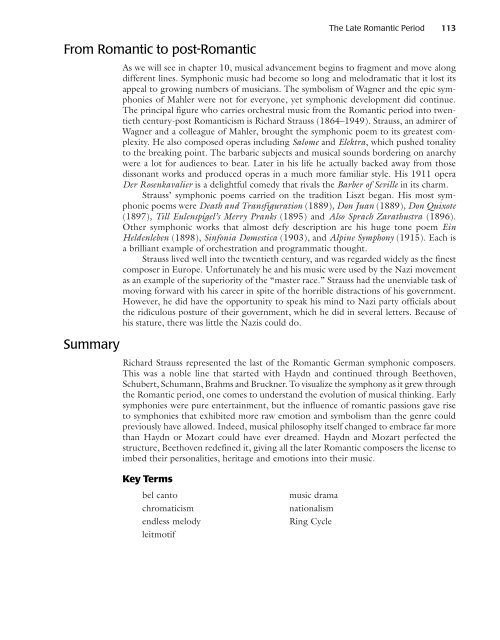Composer Profile - Activefolio
Composer Profile - Activefolio
Composer Profile - Activefolio
You also want an ePaper? Increase the reach of your titles
YUMPU automatically turns print PDFs into web optimized ePapers that Google loves.
From Romantic to post-Romantic<br />
Summary<br />
The Late Romantic Period 113<br />
As we will see in chapter 10, musical advancement begins to fragment and move along<br />
different lines. Symphonic music had become so long and melodramatic that it lost its<br />
appeal to growing numbers of musicians. The symbolism of Wagner and the epic symphonies<br />
of Mahler were not for everyone, yet symphonic development did continue.<br />
The principal figure who carries orchestral music from the Romantic period into twentieth<br />
century-post Romanticism is Richard Strauss (1864–1949). Strauss, an admirer of<br />
Wagner and a colleague of Mahler, brought the symphonic poem to its greatest complexity.<br />
He also composed operas including Salome and Elektra, which pushed tonality<br />
to the breaking point. The barbaric subjects and musical sounds bordering on anarchy<br />
were a lot for audiences to bear. Later in his life he actually backed away from those<br />
dissonant works and produced operas in a much more familiar style. His 1911 opera<br />
Der Rosenkavalier is a delightful comedy that rivals the Barber of Seville in its charm.<br />
Strauss’ symphonic poems carried on the tradition Liszt began. His most symphonic<br />
poems were Death and Transfiguration (1889), Don Juan (1889), Don Quixote<br />
(1897), Till Eulenspigel’s Merry Pranks (1895) and Also Sprach Zarathustra (1896).<br />
Other symphonic works that almost defy description are his huge tone poem Ein<br />
Heldenleben (1898), Sinfonia Domestica (1903), and Alpine Symphony (1915). Each is<br />
a brilliant example of orchestration and programmatic thought.<br />
Strauss lived well into the twentieth century, and was regarded widely as the finest<br />
composer in Europe. Unfortunately he and his music were used by the Nazi movement<br />
as an example of the superiority of the “master race.” Strauss had the unenviable task of<br />
moving forward with his career in spite of the horrible distractions of his government.<br />
However, he did have the opportunity to speak his mind to Nazi party officials about<br />
the ridiculous posture of their government, which he did in several letters. Because of<br />
his stature, there was little the Nazis could do.<br />
Richard Strauss represented the last of the Romantic German symphonic composers.<br />
This was a noble line that started with Haydn and continued through Beethoven,<br />
Schubert, Schumann, Brahms and Bruckner. To visualize the symphony as it grew through<br />
the Romantic period, one comes to understand the evolution of musical thinking. Early<br />
symphonies were pure entertainment, but the influence of romantic passions gave rise<br />
to symphonies that exhibited more raw emotion and symbolism than the genre could<br />
previously have allowed. Indeed, musical philosophy itself changed to embrace far more<br />
than Haydn or Mozart could have ever dreamed. Haydn and Mozart perfected the<br />
structure, Beethoven redefined it, giving all the later Romantic composers the license to<br />
imbed their personalities, heritage and emotions into their music.<br />
Key Terms<br />
bel canto music drama<br />
chromaticism nationalism<br />
endless melody<br />
leitmotif<br />
Ring Cycle



